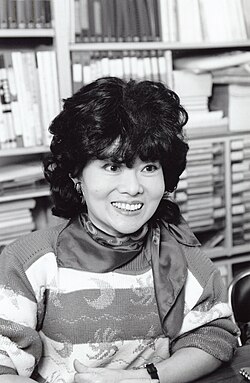Biography:Fumiko Yonezawa
Fumiko Yonezawa | |
|---|---|
 | |
| Born | 1938 Suita-City, Osaka Prefecture, Japan |
| Died | 17 January 2019 Shinagawa, Tokyo, Japan |
| Nationality | Japanese |
| Alma mater | Kyoto University, BSc, MSc and PhD |
| Spouse(s) | Masaharu Yonezawa |
| Awards | Saruhashi Prize L'Oréal-UNESCO For Women in Science Awards |
| Scientific career | |
| Institutions | Kyoto University Tokyo Institute of Technology Keele University Keio University |
| Academic advisors | Roy McWeeny
Joel Lebowitz Hideki Yukawa Takeo Matsubara |
Fumiko Yonezawa (Japanese: 米沢 富美子; 1938 – 17 January 2019) was a Japanese theoretical physicist. She was the first woman to be appointed as the President of the Physical Society of Japan and the first Japanese to have studied at Keele University, Staffordshire, United Kingdom. She was one of the founding members of the Department of Physics at the Faculty of Science and Technology, Keio University, Japan. Her research covered semi-conductors and liquid metals. She led a group of scientists and pioneered in visualising computer simulation.
Early life and education
Fumiko Yonezawa was born in Suita-city, Osaka , Japan. She lost her father in WW2 at the age of 5 and her mother, Toshiko, became the main breadwinner of the family, supporting the two young children, Fumiko and her baby sister, and her grandmother.
Yonezawa graduated from Ibaraki High School in Osaka, and went on to obtain BSc, MSc and Ph.D from Kyoto University, and spent a year researching under Professor Roy McWeeny at Keele University in the United Kingdom during her doctoral studies.
Academic career
Yonezawa spent her early career in Kyoto and Tokyo where she published her work on Coherent Potential Approximation (CPA).
In 1972, the family moved to East Coast in USA.when her husband was assigned to the New York office. Yonezawa took research jobs at Yeshiva University and Center of the City University of New York.
After the family moved back to Japan in 1976, she was appointed Associate Professor at the Yukawa Institute of Theoretical Physics at Kyoto University. In 1981, she was invited to join the founding faculty of the newly established Department of Physics at the Faculty of Science and Technology, Keio University and was made Professor of Physics in 1983.
She led a group of scientists at Keio University, simulating amorphous structures using computers and then creating visualizations of them.[1]
She was made President of the Physics Society of Japan in 1996, the first woman to hold the position.[2]
Recognitions
Yonezawa has received many recognition and awards for her contribution to Physics, including in 1984 awarded the Saruhashi Prize and in 2005 awarded L'Oréal-UNESCO Award for Women in Science for "pioneering theory and computer simulations on amorphous semiconductors and liquid metals."
Legacy
- The Physical Society of Japan created Fumiko Yonezawa Memorial Prize to award female society members each year for their contribution to Physics.
- In 1995, Suita-City created Fumiko Yonezawa Children's Science Award. Yonezawa served as one of the selection committee until her death. The award still continues each year to inspire many young minds into science.
- Following her death, Keio University set up a Fumiko Yonezawa Award for female scientists.
- In 2023, Keele University unveiled a plaque in memory of their first Japanese student.
Personal life
Yonezawa married Masaharu (1936–1996), an economics graduate whom she met at Kyoto University. They had three daughters. In 1963, a year after they married, Masaharu was assigned by his employer to study at London School of Economics and Political Science. The company policy didn't allow spouses to accompany them, so Fumiko visited the British Council in Kyoto and wrote a letter to 30 vice-chancellors of universities in the UK asking for a scholarship to study in graduate school. Two universities responded to her letter. Fumiko chose to study at Keele University in Staffordshire. This allowed the couple to meet every weekend during their UK studies.
She died on 17 January 2019, aged 80.[3]
Selected publications
- Yonezawa, Fumiko; Morigaki, Kazuo (1973). "Coherent Potential Approximation". Progress of Theoretical Physics Supplement 53: 1–76. doi:10.1143/PTPS.53.1. Bibcode: 1973PThPS..53....1Y.
- Nosé, Shuichi; Yonezawa, Fumiko (1986). "Isothermal–isobaric computer simulations of melting and crystallization of a Lennard-Jones system". The Journal of Chemical Physics 84 (3): 1803. doi:10.1063/1.450427. Bibcode: 1986JChPh..84.1803N.
- Yonezawa, F. (1 October 1968). "A Systematic Approach to the Problems of Random Lattices. I: A Self-Contained First-Order Approximation Taking into Account the Exclusion Effect". Progress of Theoretical Physics 40 (4): 734–757. doi:10.1143/PTP.40.734. Bibcode: 1968PThPh..40..734Y.
- Yonezawa, Fumiko; Matsubara, Takeo (March 1966). "Note on Electronic State of Random Lattice. II". Progress of Theoretical Physics 35 (3): 357–379. doi:10.1143/PTP.35.357. Bibcode: 1966PThPh..35..357Y.
References
- ↑ Kodate, Naonori; Kodate, Kashiko (2015). Japanese Women in Science and Engineering: History and Policy Change. Routledge. p. 98. ISBN 978-1-317-59505-2.
- ↑ Kameda, Atseko (2011). Fujimura-Fanselow, Kumiko. ed. Transforming Japan: How Feminism and Diversity Are Making a Difference. New York: Feminist Press at CUNY. p. 141. ISBN 978-1-55861-700-1.
- ↑ "日本の女性科学者の草分け、米沢富美子さん死去" (in ja). 2019-01-21. https://www.yomiuri.co.jp/science/20190121-OYT1T50114.html. Retrieved 2019-10-25.
Further reading
- Kozai, Yoshihide (2001). My Life: Twenty Japanese Women Scientists. Uchida Rokakuho. pp. 43–.
External links
- Prof. Fumiko Yonezawa, 2005 For Women In Science Laureate for Asia/Pacific (Japan) on YouTube, L’Oréal Foundation
- https://www.yorkpress.co.uk/news/7936737.york-to-be-big-in-japan/
 |



